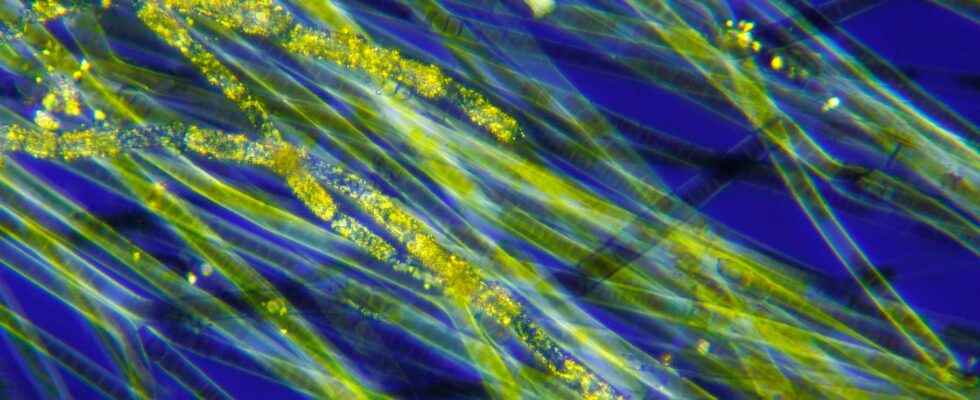You will also be interested
[EN VIDÉO] Will tomorrow’s biofuels be based on algae? European researchers are testing the performance, but also the profitability of a latest-generation biofuel that contains algae: they have produced enough to run a car and have embarked on the production of dedicated algae.…
The cyanobacteria are of interest to researchers, among other things for their ability to fix the carbon and thenitrogen. But also for their ability to photosynthesis. Synechocystis is one of them. A ” blue algae » — algae in quotes because basically a cyanobacterium is not really an algae — widespread and non-toxic. And some Cambridge University researchers (United Kingdom) have just succeeded, thanks to her, in water and a little lightof sun to feed a microprocessorcontinuously for several months — and counting.
The system they designed is no bigger than a AA battery . It is made of common, inexpensive and widely recyclable materials. And unlike a battery, it does not discharge. Since the ” algae blue » it contains continuously harvest sunlight by photosynthesis to generate a current. All with the help of a simpleelectrode in aluminium.
Photovoltaic electricity even in the dark
Researchers observe that even when the sun is down, “blue algae” seem to continue to process some of their food. Thus generating a Electric powereven in the dark. A current which remains however modest in the current state of work.
But such systems based on“blue algae” should be enough to power the internet of things. All these small connected objects — smart watchesfrom temperature sensors, etc. — which only need a small amount of energy to operate. Experts estimate there could be billions in the market by 2035. And powering them using lithium ion batteries , even if charged by solar energy, could end up costing our planet resources. Three times more lithium than what is currently produced in the world, in particular.
Algae to capture solar energy?
Several laboratories are exploring the path of artificial photosynthesis to exploit the energy of the Sun. A group of engineers from Stanford University almost reversed existing work by using… natural photosynthesis. Electricity was produced directly by algae.
Article of Laurent Sacco published on 04/22/2010
For years, attempts have been made to exploit solar energy in many ways. It is an increasingly urgent problem to meet the energy needs of the growing world population as the fossil fuels are running out and environmental problems are on the rise. The project Iter has of course been launched, but the problems posed by controlled fusion are formidable and it will take decades to overcome them.
Much research is currently trying to improve the performance of photovoltaic cells and lower production costs. Some seek to imitate the photosynthesis reactions of plant cells, or are inspired by them, to carry out artificial energy-producing photosynthesis. One can quote for example the works of the group of researchers of the MIT trying to produce energy with the help of a virusor those of engineers from the University of Cincinnati, who, curiously, found inspiration in the frog.
A group of researchers from Stanford University has managed to do something remarkable. As the engineers have just explained in an article published in Nano Lettersthey succeeded in directly exploiting the currents of electrons produced by the conversion of solar photons inside the living cells of unicellular algae, Chlamydomonas.
Scaling will be difficult
To do this, it was necessary to achieve a small feat: to immerse gold electrodes inside the verychloroplasts . It is precisely in theseorganelles(equivalents of organs for a cell) that the photons are captured by the cells, their energy being converted into a current of electrons.
The currents extracted by the researchers from each of the cells are of course very low, of the order of one pico-ampere, or one millionth of a millionth ofampere . It would take a trillion cells to produce the energy stored in a single standard AA battery in one hour. In addition, the electrodes threaten theintegrityliving cells that die fairly quickly and less lethal electrodes should be developed.
However, the method could be promising because the efficiency of the solar energy conversion process is already 20% in the experiments carried out and the researchers believe that there is no reason why it should not be possible. achieve yields close to 100%.
It still does not seem obvious to achieve the same feat on a large scale, which would in any case be necessary to compete with conventional photovoltaic cells whose yields oscillate between 20 and 40%.
Interested in what you just read?
